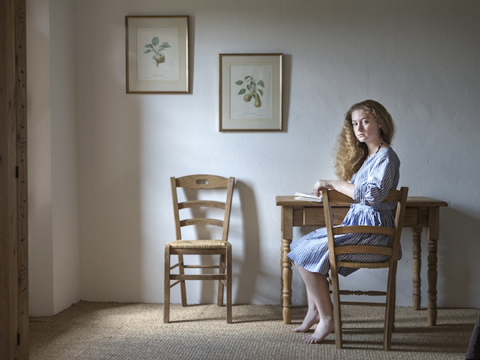 ‘Lou Lou at Callian’ digital archival print, 2014, by Jack Montgomery. |
Susan Maasch Fine Art is showing solos of two widely different artists: abstract painter Jessica Gandolf and photographer Jack Montgomery. As presented in the gallery, both artists appear at crossroads right now. Each shows a few pieces that are more in line with previous work, but the majority of the works explores new directions. At the same time, both artists draw inspiration from art history.
Gandolf, who comes from figuration and magical realism, shows 14 recent oils on panel. Even within her abstract body of work, in these new pieces Gandolf has come a long way from earlier awkward remnants of figuration and gravitational forces, as well as too easily digestible patterning and symmetry, and has arrived at sophisticated rhythmic resolutions that recall the work of Paul Klee and Franz Marc. In “Collina” for instance, interwoven shapes and colors subtly suggest a landscape and village view with barely-there intimations of roofs and entire houses in a muted palette.
Gandolf’s intuitive working process is richly visible through overpainting, pleasant imprecision of edges, and visible brushstrokes. With the exception of occasional suggestions of receding planes, her elemental intertwining and visible layering alone does not read as space and time, although we understand the sequential and spatial process. Structure, instead, is in the foreground, but generally does not dominate. Where it does, however, the work can become too decorative, as in “Canopy,” in which undulations, vague symmetries, and a very limited color choice prevail. And where different formal vocabularies get mixed, as in “Back Shore,” the visual language fails to suggest a coherent whole.
The vast majority of Gandolf’s paintings, however, shine. Moving away from local color and suggestions of landscape to complete abstraction and vibrant color schemes, they embrace an easy balance between colors and organic and geometric forms that is complex and daring enough to grab your attention and challenge nicety and decorativeness. While at first glance the composition of “Leaning Bright” might appear simple and just pleasing to the eye, it is actually a complex vortex of multiple configurations and relationships. Gandolf’s best paintings are thus resolved into tonal and formal rhythms, pulsating with energy and joy.
Montgomery is best known for his sensitive black-and-white portraits, among them those of firemen in lower Manhattan after 9/11, Maine Holocaust survivors, and adolescent and genderbending individuals growing into themselves. His working method is always collaborative in nature and empowering to his subjects. A couple of photographs in the Maasch show still fit that description, but generally speaking the seven pieces present a major departure in which Montgomery appears to assert himself stylistically, yet also becomes less daring.
Moving from portraiture proper to interior scenes in which subject and set carry equal weight, time appears to have stood still a while back. Montgomery is not only drawing inspiration from personal favorites in the canon of art history, including Andrew Wyeth, Jan Vermeer, and other painters of the Dutch Golden Age, but creates scenes in their manner.